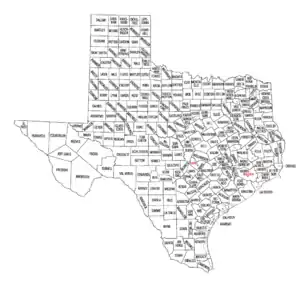Outline of Texas
The following outline is provided as an overview of and topical guide to Texas:

The Flag of the State of Texas

The obverse of the Seal of the State of Texas

The location of the State of Texas in the United States of America
Texas – second most populous and the second most extensive of the 50 states of the United States of America. Texas borders Mexico and the Gulf of Mexico in the South Central United States. Texas is placed in the Southern United States by the United States Census Bureau.[1] The Republic of Texas joined the United States as the 28th state on December 29, 1845. Texas joined the Confederate States of America during the American Civil War from 1861 to 1865 but was readmitted to the Union in 1870.
General reference

An enlargeable map of the State of Texas
- Names
- Common name: Texas
- Pronunciation: /ˈtɛksəs/ (
 listen)
listen)
- Pronunciation: /ˈtɛksəs/ (
- Official name: State of Texas
- Abbreviations and name codes
- Nicknames
- Lone Star State[2][3] (used on license plates)
- Chili State
- Common name: Texas
- Adjectival: Texas
- Demonyms:
Geography of Texas
- Texas is: a U.S. state, a federal state of the United States of America
- Location
- Population of Texas: 25,145,561 (2010 U.S. Census[4])
- Area of Texas: 268,581 square miles (695,622 km2)
- Atlas of Texas
Places in Texas
- Historic places in Texas
- National Natural Landmarks in Texas
- National parks in Texas (2)
- State parks in Texas
Environment of Texas
- Climate of Texas
- Geology of Texas
- Protected areas in Texas
- Superfund sites in Texas
- Save Our Springs Alliance
- Texas Natural Resources Information System
- Wildlife of Texas
- Fauna of Texas
Natural geographic features of Texas
Regions of Texas
Administrative divisions of Texas

An enlargeable map of the 254 counties of the state of Texas
- The 254 counties of the state of Texas
- Municipalities in Texas
- Cities in Texas
- State capital of Texas: Austin
- Largest city in Texas: Houston (fourth-largest city in the United States)
- City nicknames in Texas
- Towns in Texas
- Unincorporated communities in Texas
- Cities in Texas
- Municipalities in Texas
Demography of Texas
- German Texan
- History of African-Americans in Texas
- History of African Americans in Houston
- History of African Americans in Dallas-Ft. Worth
- History of African Americans in San Antonio
- Jewish history in Texas
- Hispanics and Latinos in Texas
- History of Mexican-Americans in Texas
- History of Mexican Americans in Houston
- History of Mexican Americans in Dallas-Fort Worth
Government and politics of Texas
- Form of government: U.S. state government
- United States congressional delegations from Texas
- Texas State Capitol
- Elections in Texas
- Political party strength in Texas
Branches of the government of Texas
Executive branch of the government of Texas
Legislative branch of the government of Texas
Law and order in Texas
History of Texas
History of Texas, by period
- Prehistory of Texas
- Early Spanish exploration, 1519
- French colonization of Texas, 1684–1689
- Spanish Texas, as part of the Viceroyalty of New Spain, 1690–1821
- History of slavery in Texas
- Parts of the current state were also included in the following provinces of New Spain
- Nueva Vizcaya, 1577–1821
- Santa Fe de Nuevo México, 1598–1821
- Nuevo Santander, 1746–1821
- Commandancy General of the Provincias Internas
- Spanish missions in Texas
- French colony of Louisiane, 1699–1764
- Spanish (though predominantly Francophone) district of Baja Luisiana, 1764–1803
- Third Treaty of San Ildefonso of 1800
- French district of Basse-Louisiane, 1803
- Louisiana Purchase of 1803
- Territorial claims of United States Louisiana Purchase, 1803–1821
- Sabine Free State, 1806–1821
- Adams–Onís Treaty of 1819
- Mexican War of Independence, 1810–1821
- Gutiérrez–Magee Expedition, 1812–1813
- Long Expedition, 1819
- Treaty of Córdoba of 1821
- Mexican Texas, 1821–1836
- The Constitution of Mexico of 1824 created the state Coahuila y Tejas from Spanish Texas and Coahuila.
- Parts of the current state of Texas were also included in the following Mexican states
- Chihuahua, since 1824
- Nuevo León, since 1824
- Tamaulipas, since 1824
- Santa Fe de Nuevo México, 1824–1848
- Coahuila, since 1836
- Texas Revolution, 1835–1836
- Timeline of the Texas Revolution
- Treaties of Velasco, 1836
- Texas Declaration of Independence, 1836
- Republic of Texas, 1836–1845
- Texas–Indian Wars, 1836–1875
- Republic of the Rio Grande, 1840
- U.S. State of Texas since December 29, 1845
- Texas annexation of 1845
- Mexican–American War, 1846–1848
- Treaty of Guadalupe Hidalgo of 1848
- Compromise of 1850
- Northwestern territorial claims ceded 1850
- Texas in the American Civil War, 1861–1865; part of the Confederate States of America
- Texas in Reconstruction, 1865–1870
- Comanche Campaign, 1868–1874
History of Texas, by region
History of Texas, by subject
- History of education in Texas
- History of Texas forests
- History of law enforcement in Texas
- History of religion in Texas
- History of slavery in Texas
- History of sports in Texas
Culture of Texas
- Museums in Texas
- Religion in Texas
- The Church of Jesus Christ of Latter-day Saints in Texas
- Episcopal Diocese of Texas
- Jewish history in Texas
- Scouting in Texas
- State symbols of Texas
- Texas cuisine
The arts in Texas
Sports in Texas
Economy and infrastructure of Texas
- Communications in Texas
- Health care in Texas
- Transportation in Texas
Education in Texas
See also
- Topic overview:
- All pages with titles beginning with Texas
- All pages with titles beginning with Texan
- All pages with titles beginning with Tejano
- All pages with titles beginning with Texian
- All pages with titles containing Texas
- All pages with titles containing Texan
- All pages with titles containing Tejano
- All pages with titles containing Texian
References
- "Census Regions and Divisions of the United States" (PDF). United States Census Bureau. Retrieved July 2, 2016.
- "Texas:Facts, Map, and State Symbols". EnchantedLearning.com. Retrieved 2008-03-09.
- Barry Popik, Smoky City, barrypopik.com website, March 27, 2005
- "U.S. Census Bureau State & County QuickFacts Texas". Archived from the original on 2013-10-23. Retrieved 2011-11-18.
External links
This article is issued from Wikipedia. The text is licensed under Creative Commons - Attribution - Sharealike. Additional terms may apply for the media files.